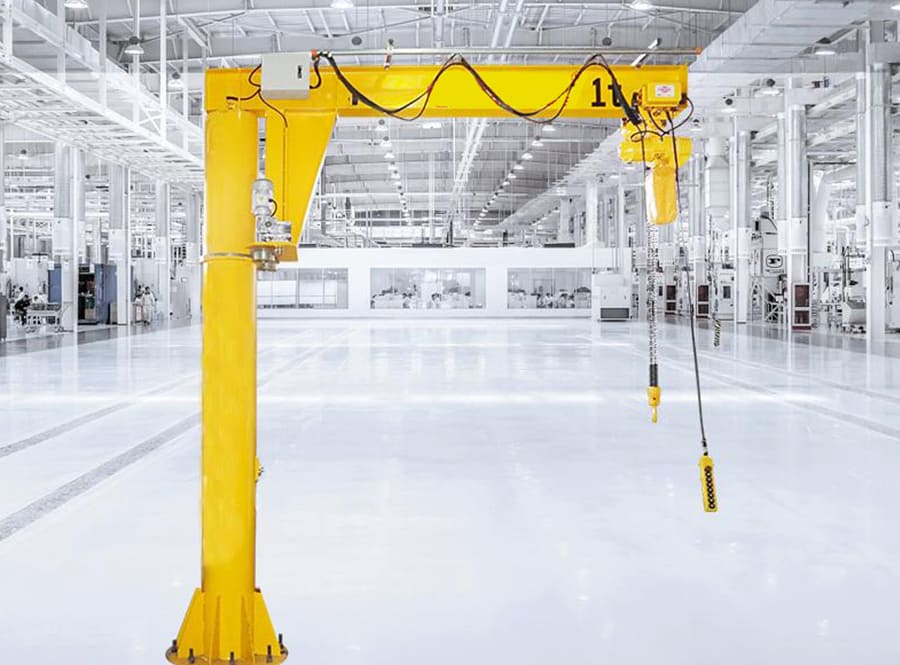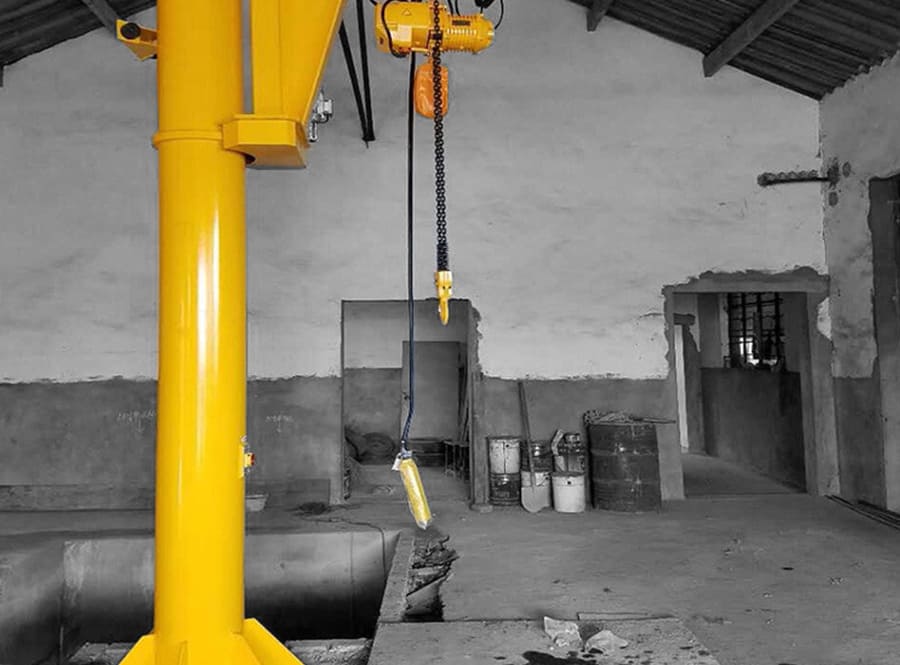Jib hyskrane is 'n tipe heftoerusting wat wyd gebruik word in nywerhede wat doeltreffende en buigsame materiaalhanteringsoplossings benodig. Met hul unieke ontwerp en veelsydigheid bied jib hyskrane verbeterde manoeuvreerbaarheid en gemak van bediening. Hierdie artikel sal die kenmerke, voordele en toepassings van krukkrane ondersoek.
Kenmerke en ontwerp:
'n Kikkerkraan bestaan uit 'n vertikale mas of pilaar wat 'n horisontale balk ondersteun, ook bekend as 'n knikarm. Die jib-arm kan tot 360 grade draai, wat volle dekking binne sy werksradius moontlik maak. Aan die einde van die jib arm is 'n hyser of hysmeganisme gemonteer wat die hyskraan in staat stel om swaar voorwerpe met gemak op te lig en te beweeg. Jib-krane kom in verskeie konfigurasies, soos vrystaande, muurgemonteerde of plafongemonteerde, na gelang van die spesifieke toepassingsvereistes.

Buigsaamheid en manoeuvreerbaarheid: Jib-hyskrane bied uitstekende buigsaamheid en manoeuvreerbaarheid, wat hulle geskik maak vir omgewings met beperkte spasie. Hul vermoë om te draai en verskillende areas binne hul werksradius te bereik, verseker doeltreffende materiaalhantering in gebiede wat uitdagend kan wees om toegang te verkry met ander tipes hyskrane.
Maklike installasie: Jib-hyskrane is relatief maklik om te installeer in vergelyking met groter oorhoofse hyskrane. Hulle benodig minimale wysigings aan die bestaande struktuur, en sommige modelle kan direk aan die vloer of muur vasgebout word, wat stilstandtyd tydens installasie tot die minimum beperk.
Presiese vragposisionering: Jib-hyskrane bied presiese vragposisionering, danksy hul vermoë om die jib-arm te draai en uit te brei. Operateurs kan die vrag maklik akkuraat plaas, wat die risiko van skade of ongelukke tydens opheffing en beweging verminder.
Koste-effektiewe oplossing: Jib-hyskrane is 'n koste-effektiewe hysoplossing, veral vir ligte tot medium-diens opheffing take. Hulle bied 'n laer aanvanklike belegging in vergelyking met groter oorhoofse hyskrane, wat dit 'n aantreklike opsie maak vir klein en mediumgrootte besighede.

Toepassings van Jib Cranes:
Vervaardigings- en produksiefasiliteite: Jib-hyskrane word algemeen gebruik in vervaardigings- en produksiefasiliteite vir die opheffing en verskuiwing van materiale, komponente en voltooide produkte langs monteerlyne. Hulle is veral nuttig in werkstasies waar herhalende opteltake vereis word.
Pakhuise en verspreidingsentrums: Krane word in pakhuise en verspreidingsentrums gebruik om goedere van houers, vragmotors en rakke te laai en af te laai. Hulle fasiliteer doeltreffende materiaalhantering, verminder hande-arbeid en verhoog produktiwiteit.
Konstruksieterreine: Krane word op konstruksieterreine gebruik vir die opheffing van swaar konstruksiemateriaal, soos staalbalke, voorafvervaardigde betonpanele en masjinerie. Hul kompakte ontwerp en manoeuvreerbaarheid maak hulle geskik vir die navigasie van stywe of oorbelaste konstruksie-areas.
Motor- en instandhoudingsfasiliteite: Jib-hyskrane word algemeen gevind in motorwerkswinkels en instandhoudingsfasiliteite vir die opheffing en posisionering van enjins, transmissies en ander swaar motorkomponente tydens herstel- en instandhoudingstake.
Afsluiting:
Jib-hyskrane bied 'n veelsydige en doeltreffende hysoplossing in verskeie industrieë. Hul buigsaamheid, manoeuvreerbaarheid en gemak van installasie maak hulle ideaal vir omgewings met beperkte spasie. Of dit nou in vervaardiging, pakhuise, konstruksieterreine of motorfasiliteite is, krukkrane bied presiese vragposisionering en verbeter materiaalhanteringsaktiwiteite. Met hul kostedoeltreffendheid en praktiese ontwerp, bly kraankrane steeds 'n waardevolle bate vir besighede wat hul optel- en hanteringsprosesse meer vaartbelyn wil maak.
